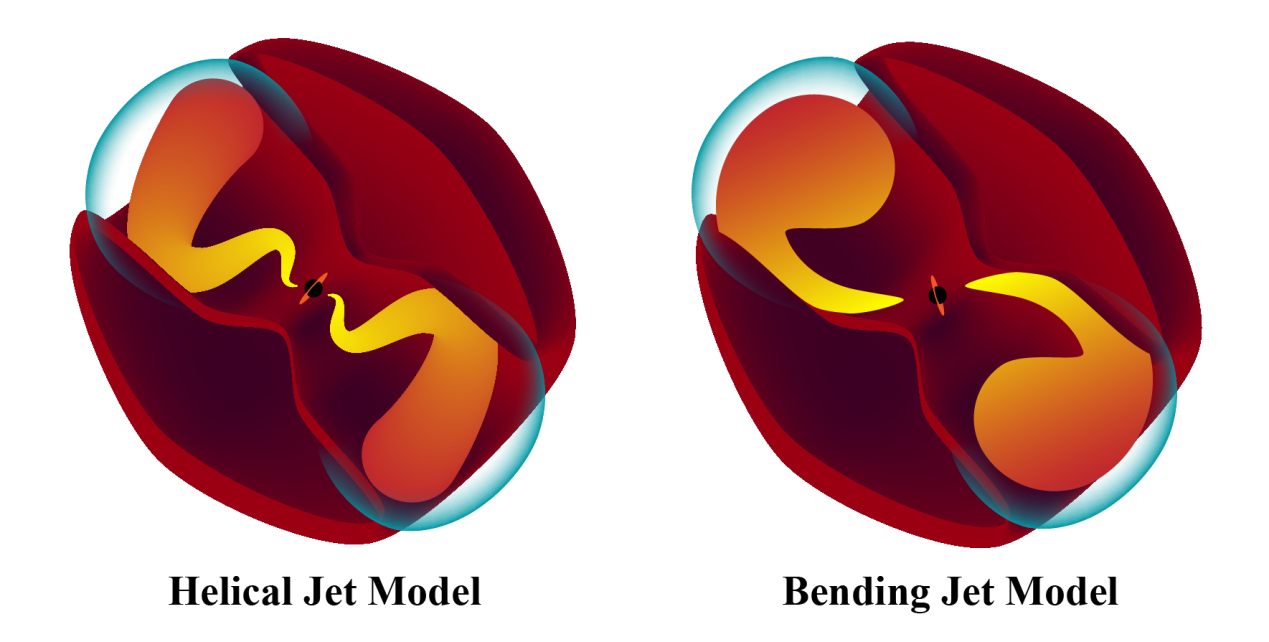Mrk 231- The Immature Radio Quasar
Active Galactic Nuclei (AGN) is a very special class of extragalactic objects. Quasars are extremely bright AGNs. Quasars can be divided into radio quiet and radio loud quasars according to the ratio of radio intensity relative to optical intensity of quasars. How the black hole at the center of the active galaxy affects its host galaxy, and whether radio quiet and radio loud quasars can be unified, is still a hot issue to be solved in this field.
Recently, an international team led by researchers from the Shanghai Astronomical Observatory (SHAO), Chinese Academy of Sciences, has made new progress in this field. By analyzing the multi-epoch Very Long Baseline Interferometry (VLBI) data of Mrk 231, they find that the jet in its quiet state is sub-relativistic. They also find that the jet was oscillating in a cone-shaped cavity with a large opening angle of about 60 degrees.
As to the reason of choosing Mrk 231 as the research object, the corresponding author, Prof. AN Tao from SHAO explained that Mrk 231 is the closest radio quiet quasar known and one of the most luminous infrared galaxies in the local Universe. Its significant radio jets and powerful multi-phase/multi-scale outflows make it an ideal laboratory to study outflows, jets, and AGN feedback.
Wide-angle outflows on sub-kpc to kpc scales are ubiquitous in radio quiet quasars. Most studies believe that the radiation pressure of quasars is the main driving force of AGN wind (or outflow). The X-ray, optical, and millimeter observations of Mrk 231 have all shown the existence of powerful outflow, whose influence extends from the core region to a scale of about 10,000 light-years.
“In addition to the outflow, based on the radio observation, we also find that the existence of jets. But the jet collimation is poor.” The first author of the work, a graduate student, WANG Ailing said, "by further tracking the interaction between the jet and the interstellar medium, we found that over time, the position of the point of action continues to change, which will produce a large-angle shock wave. Through the shock wave, the mechanical energy carried by the jet will be dissipated in the interstellar medium, further promoting the propagation of the outflow on a larger scale. "
The jet energy in the quiet state only accounts for a small part of the outflow energy, but the jet mechanical energy in the flaring state will increase by 1-2 orders of magnitude. It suggest that the contribution of the jet to powering the outflows is not negligible when Mrk 231 is in its flaring state.
"Unlike the radio-loud quasars that usually have collimated and highly relativistic jet, the jets in radio-quiet quasars are less powerful and uncollimated. The jet direction changes within the large-opening-angle cone. This causes lower time-averaged kinetic energy and momentum in a specific direction, compared to that of a collimated jet flow.
Moreover, a substantial fraction of the jet power is dissipated in radiation. Consequently, the Mrk 231 jet is obstructed by the dense ISM within a few tens pc scale and fails to grow into a large-sized radio source," Prof. AN said.
There may be two causes leading to the change. First, it could be due to the projection effect of a helical jet. Since Mrk 231 is a merged galaxy, there could be two large black holes in the center of the galaxy. The young brother black hole’s tidal gravitational action on the black hole brother may cause the jet to precess, forming a spiral shape. Another cause could be the influence of the circum-nuclear disc caused to the rotation of the jet.
Mrk 231 sits between the radio-loud and radio-quiet quasars, and the physical properties of its jet and interstellar medium are typical and representative. The study of Mrk231 and AGN with similar nature will further verify whether radio quiet and radio loud AGN can be unified. The research team will carry out further relevant research in this field in the future.

Fig. 1 The copyright of this picture belongs to the original author, Dr. Xiaolong Yang. Please indicate the source and original author for reprinting or quoting.
Paper link:
https://academic.oup.com/mnras/advance-article/doi/10.1093/mnras/stab587/6157752
Scientific contact:
AN Tao, Shanghai Astronomical Observatory, antao@shao.ac.cn
WANG Ailing, Shanghai Astronomical Observatory, wal@shao.ac.cn
Press contact:
ZUO Wenwen, Shanghai Astronomical Observatory, wenwenzuo@shao.ac.cn
Download attachments:


